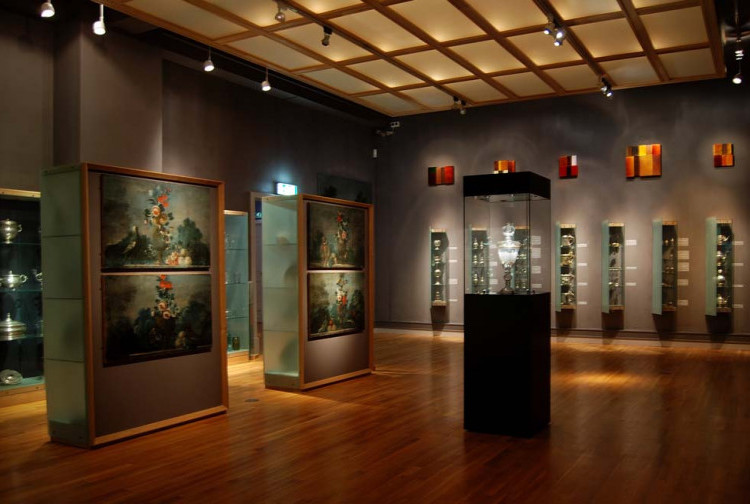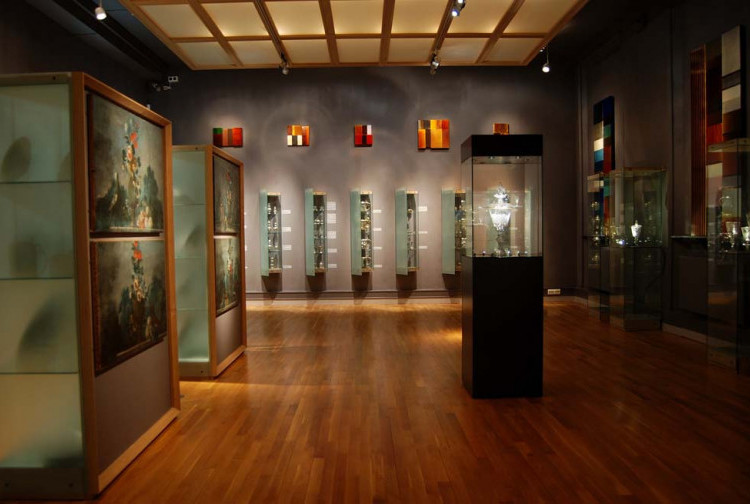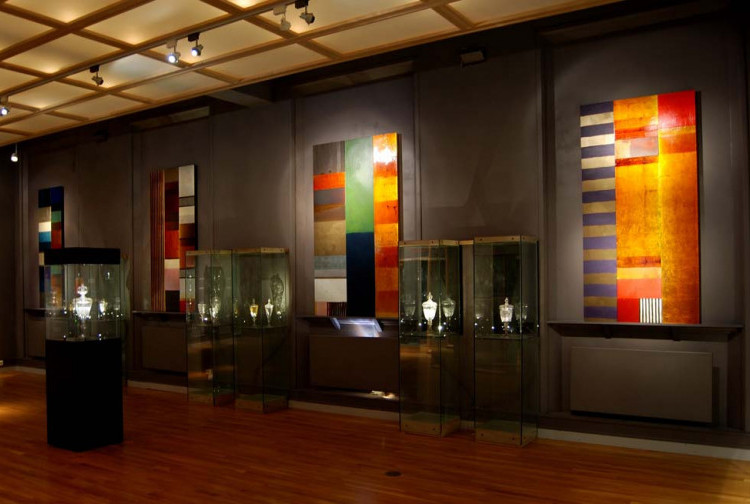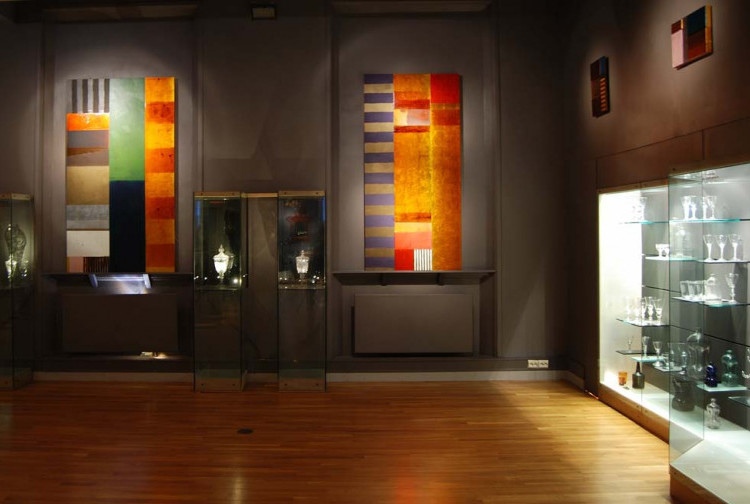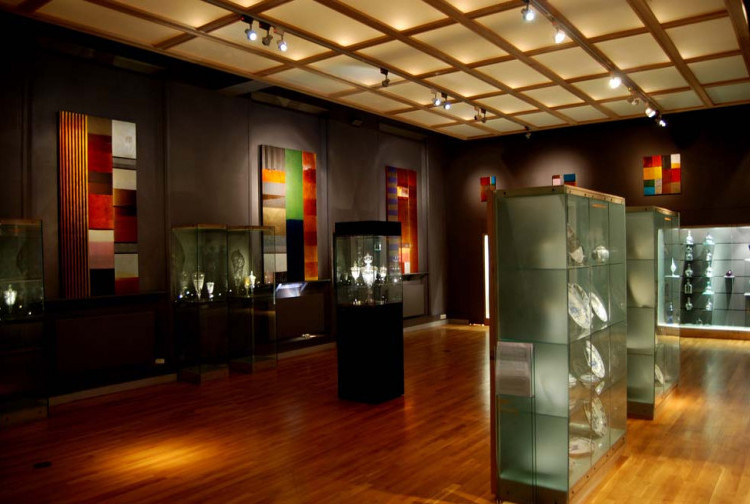Steve Joy in the Nøstetangen room
Steve Joy (b. 1952) paints abstractly. That is, he does not want to reproduce the visual environment we experience on a daily basis as lifelike as possible. Abstract painting is a hundred-year-old phenomenon and for an artist of Joy's generation, this is a form language that the artist uses as a starting point when he is to express something in the painting.
Character tips
Joy works in a geometric tradition and there is as much other art and culture, as naturalistic and dreamy visual experiences, he is in dialogue with. Because as André Malraux said, one does not become a composer by going out into the woods to listen to the birds singing, but by going to concerts and listening to music.
For Steve Joy, there is something natural in painting in the abstract way. He builds on the grammar of artists such as Piet Mondrian (1872-1944) and Barnett Newman (1905-1970), and of contemporary artists such as Sean Scully (b. 1945). Behind the geometric, in stripes and squares, there are still natural phenomena, but they are strongly abstracted or conventionalized. Painting in this way presupposes that the artists have first studied modern visual art - gone to galleries and museums and looked at art - and learned a design language. The audience eventually does the same, because seeing modern art requires effort just as learning another language does. Learning to look at abstract art is still much easier than learning Greek, but it requires that you do not look for things you do not want to find, such as lifelike reproductions of human bodies, flower bouquets, fjord landscapes or allegories of moral values. To become "fluid" in modern painting, one must see a lot and become familiar with the development within what is today a valuable tradition.
The design language Joy works in was coded as early as the 1910s and further developed in the 1950s and 60s. Abstract painting as it appeared in New York in the 1950s introduced a new way of looking at visual art. In addition to contemplating the illusion of the visual room about a visual world, the physical surface and materiality of the painting itself became an important part of the experience. The abstract painting tends to be visually quite flat. The image space is drawn towards the viewer and ends up as a sign of the painted surface. This means that the image affects the actual room the viewer is in. The modern painting thus has a structure that consists of three parts, the room where the viewer stands in front of the image, the image itself as a physical object and painted screen, and the virtual space that can be experienced clean visually inwards behind the screen.
It is this screen that is the painter's place, where he can create his patterns, ornaments and abstract images. In the geometric design language Steve Joy uses, he has the ability to create movements, rhythms and displacements up and down and back and forth across the image field. He uses only vertical and horizontal delimitations, a part of this design language that aims to emphasize the surface character and by repeating and playing against the rectangular shape of the format. In addition to this, he can paint square fields that move visually (or "pictorially") in and out of the picture space, so that what the painter Hans Hofmann (1880-1966) called a Push and Pull dynamic arises. Joy uses both of these methods, and it is with this pictorial logic as a starting point (or "vocabulary") that he creates his special expressions.
What characterizes Steve Joy's painting is that he wants to bring a spiritual experience into the picture experience. He does this by charging the painted surface with glazes and metallic fields that give the surface a visual space that explodes from the physical materiality that makes up the painting substrate. Particularly metallic surfaces can create depths of space and a trembling, visual experience of something infinite, which cannot be subjected to the rationality of the surveyor and the yardstick. It is not possible to measure how deep such a picture space is.
By switching between painted, more or less transparent and opaque fields, he can play on the difference between fairly dense fields and others that seem far more open. It is precisely these differences that, through rhythm, lengthen and rhythm in and out of the picture space, which gives the very special pulse to Joy's pictures. And this is what distinguishes his images from the others who use the same language. He uses silver, gold and copper, and it is especially the gold that brings to life the memory of orthodox icons and Byzantine mosaics. This is a stated intention from Joys'side, and he gives the viewer a tip about this by giving pictures titles such as "Icon - The Hermit of the North" and "Icon - (Byzantine) Azure". Gold was used in historical religious contexts as an abstract background, unfathomably deep as a sign of the heavenly, the promised, which can not yet be seen, but which can be imagined. Like the icon painters, Steve Joy paints on three. And he expands the image by putting different parts together, so that sometimes a circumference arises that is not purely rectangular. This connects some of his works to building structures. They become like walls with openings in. This is a logic that also lies behind Sean Scully's use of stripes and square fields, the type of patterns that can be seen on fences, roadblocks and house walls.
Steve Joy's photos have also included some of Barnett Newman's attitudes. Newman was very concerned that his abstract images should charge and tune the room in which the spectator stands, embrace the spectator and make the image with the spectator a place and such a special place that he compared it to other privileged, distinctive places like the base at Yankee Stadium and the altar in the synagogue. As with Newman, Steve Joy's religiosity is unofficial, not directly related to a particular set of dogmas and beliefs. There are few direct symbols that refer to established religions and their iconography. But in Newman it is a subtle reference to Jewish, Kabbalistic iconography and color symbolism, and in Joy it is an indirect reference to the image treasure of Christianity through the use of gold.
It is up to each individual spectator to experience these images in relation to their own experiences and attitudes. But what we all have in common is that they in space serve both as presentations and as something that wants to hold on to something that we can not really grasp and that can not really be seen. And by seeing them, not as physical windows in the room, but as windows to something beautiful, lasting and good, the exhibition succeeds in making the magnificent Nøstetangen room a special place, where the art industry's transparent glass, gilding and the shiny, radiant surfaces of silver , is enriched with symbols of something that is not mundane and not quite of this world. And in space we experience the physical splendor of this.
Steve Joy is English, but currently lives and works in the United States. He has lived and worked in Norway for many years and still has good contact with the art community here. Simultaneously with the exhibition in Drammen, a large museum exhibition takes place with Steve Joy's work in Trondheim Art Museum, where the exhibition opens on 11 June and runs until 24 September.
Åsmund Thorkildsen
Museum director and curator of the Solo project in the Nøstetangen room
Venue
Monday to Friday 11.00 - 15.00
Wednesday 11.00 – 18.00
Saturday 11.00 – 16.00 (free admission)
Sunday 11.00 – 16.00




